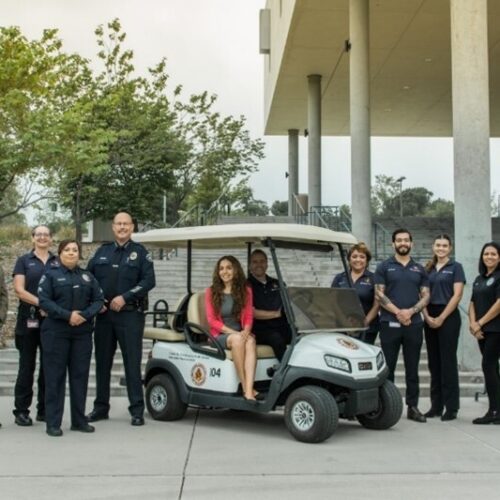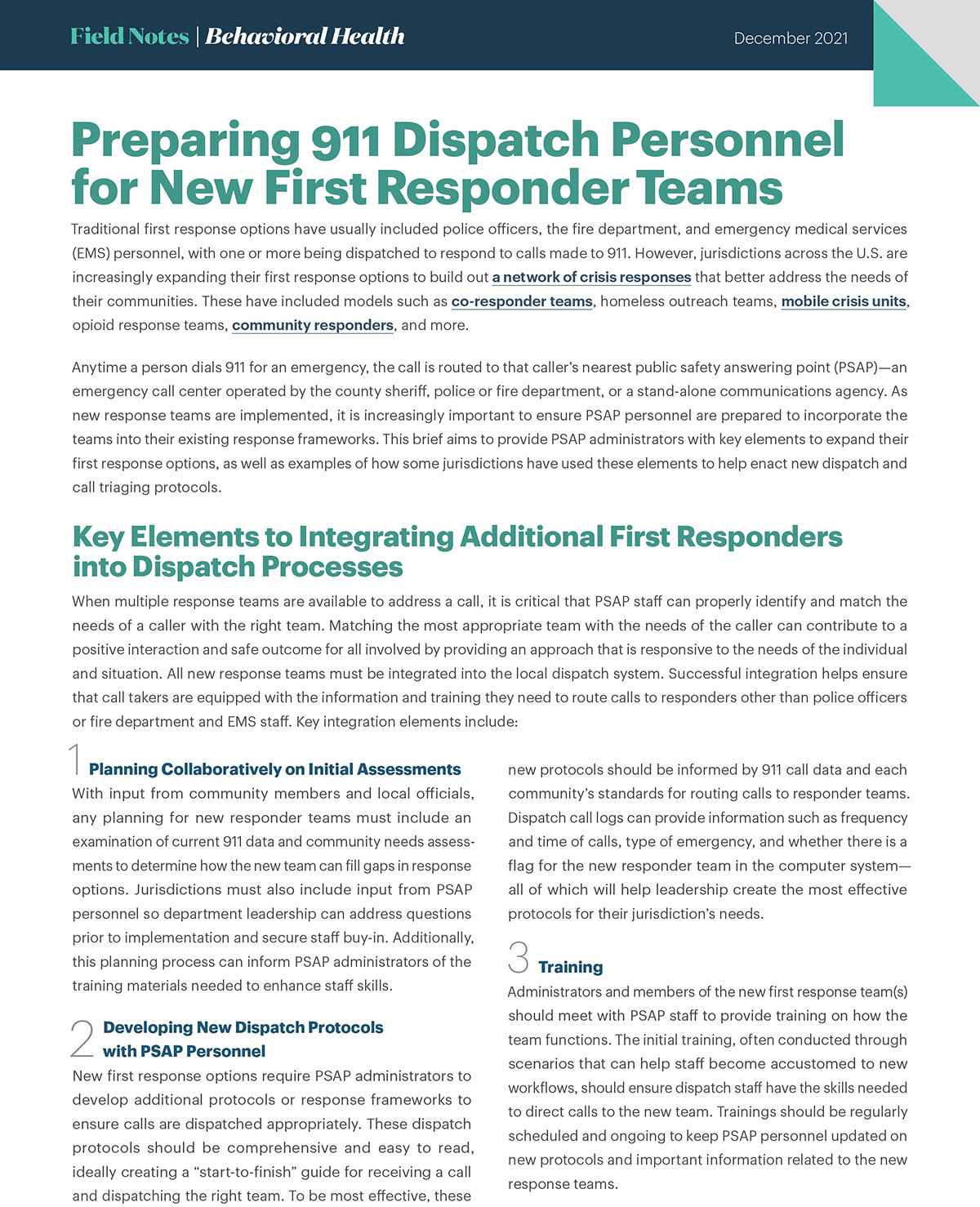Preparing 911 Dispatch Personnel for Incorporating New First Responder Teams
Traditional first response options have usually included police officers, the fire department, and emergency medical services (EMS) personnel, with one or more being dispatched to respond to calls made to 911. However, jurisdictions across the U.S. are increasingly expanding their first response options to build out a network of crisis responses that better address the needs of their communities. As new response teams are implemented, it is important to ensure PSAP personnel are prepared to incorporate the teams into their existing response frameworks. This brief aims to provide PSAP administrators with key elements to expand their first response options, as well as examples of how some jurisdictions have used these elements to help enact new dispatch and call triaging protocols.
Preparing 911 Dispatch Personnel for New First Responder Teams
Traditional first response options have usually included police officers, the fire department, and emergency medical services (EMS) personnel, with one or more being dispatched to respond to calls made to 911. However, jurisdictions across the U.S. are increasingly expanding their first response options to build out a network of crisis responses that better address the needs of their communities. These have included models such as co-responder teams, homeless outreach teams, mobile crisis units, opioid response teams, community responders, and more.
Anytime a person dials 911 for an emergency, the call is routed to that caller’s nearest public safety answering point (PSAP)—an emergency call center operated by the county sheriff, police or fire department, or a stand-alone communications agency. As new response teams are implemented, it is increasingly important to ensure PSAP personnel are prepared to incorporate the teams into their existing response frameworks. This brief aims to provide PSAP administrators with key elements to expand their first response options, as well as examples of how some jurisdictions have used these elements to help enact new dispatch and call triaging protocols.
Key Elements to Integrating Additional First Responders into Dispatch Processes
When multiple response teams are available to address a call, it is critical that PSAP staff can properly identify and match the needs of a caller with the right team. Matching the most appropriate team with the needs of the caller can contribute to a positive interaction and safe outcome for all involved by providing an approach that is responsive to the needs of the individual and situation. All new response teams must be integrated into the local dispatch system. Successful integration helps ensure that call takers are equipped with the information and training they need to route calls to responders other than police officers or fire department and EMS staff. Key integration elements include:
1. Planning Collaboratively on Initial Assessments
With input from community members and local officials, any planning for new responder teams must include an examination of current 911 data and community needs assessments to determine how the new team can fill gaps in response options. Jurisdictions must also include input from PSAP personnel so department leadership can address questions prior to implementation and secure staff buy-in. Additionally, this planning process can inform PSAP administrators of the training materials needed to enhance staff skills.
2. Developing New Dispatch Protocols with PSAP Personnel
New first response options require PSAP administrators to develop additional protocols or response frameworks to ensure calls are dispatched appropriately. These dispatch protocols should be comprehensive and easy to read, ideally creating a “start-to-finish” guide for receiving a call and dispatching the right team. To be most effective, these new protocols should be informed by 911 call data and each community’s standards for routing calls to responder teams. Dispatch call logs can provide information such as frequency and time of calls, type of emergency, and whether there is a flag for the new responder team in the computer system—all of which will help leadership create the most effective protocols for their jurisdiction’s needs.
3. Training
Administrators and members of the new first response team(s) should meet with PSAP staff to provide training on how the team functions. The initial training, often conducted through scenarios that can help staff become accustomed to new workflows, should ensure dispatch staff have the skills needed to direct calls to the new team. Trainings should be regularly scheduled and ongoing to keep PSAP personnel updated on new protocols and important information related to the new response teams.
Training Topics and Questions to Prepare PSAP Staff for Additional First Responders
The following topics and associated questions should be covered during trainings for PSAP personnel prior to the implementation of additional response teams and in regularly scheduled training opportunities.
| Topic | Questions Trainings Should Answer |
|---|---|
| Structure of team | Does the response team sit under a larger entity like the fire department or EMS? In what ways might this impact service delivery?
Who oversees the team? Who can make decisions about its policies and procedures? Who can staff contact if they find parts of the process are not working effectively? Will the team have access to the fire department or police radio channels? |
| Specializations | Who makes up the team? (e.g., clinicians, peer support specialists, medical professionals, law enforcement)
What are the specializations of the team (e.g., housing, connections to services, counseling, substance use disorders, medical crises, immediate threat/danger)? |
| Inclusion/ Exclusion Criteria | What kind of situations would qualify a call to be routed to the new response team?
What factors would disqualify a call from being routed to the new response team? |
| Ongoing Coordination | How are calls directed to the new response team?
What technology is being used by the new team (e.g., radios, computer-aided dispatch systems, tablets for telehealth)? How often are data being reviewed and elevated for necessary program improvement and cross-system alignment? What kind of cross-systems trainings will be provided and how often? |
Jurisdictions That Have Implemented New Dispatch and Call Triaging Protocols
Connecting the response team best equipped to meet the needs of a 911 caller while an emergency or crisis is in progress is of the utmost importance. Below are some examples of how jurisdictions across the county have used the key elements to successfully integrate additional first responders into their dispatch processes, including bringing together key stakeholders to design dispatch protocols that operate smoothly and effectively.
In Dane County, Wisconsin representatives from the dispatch center were involved in the planning for the CARES community responder team from the beginning. Law enforcement, Journey Health employees (the provider who run the CARES team along with the Madison Fire Department), the fire department, and dispatchers collaborated to develop the workflows and questions that dispatchers now use to determine which team to send to a call. As part of this process, stakeholders from each department came together and listened to recorded 911 calls so each agency could weigh in on which team was best situated to respond to that call. From there, they were able to establish protocols for using standard call screening questions to determine if a call could be routed to the CARES team. For example, any call where the person identified weapons on the scene, stated that someone was exhibiting assaultive or threatening behavior, or indicated that there was a need for medical services was disqualified for the community responders. However, if none of these situations were presented, but the caller was suicidal or needed a welfare check, then the CARES team could respond. Additionally, the department stakeholders decided that since CARES is under the umbrella of the fire department, and not the police department, the team would operate on the fire department’s radio channel.
Yavapai County, Arizona has sought to improve community services by introducing a co-response model and 911 deflection services. The deflection program identifies people who call into 911 reporting a mental health-related crisis and dispatches a mobile crisis intervention team in lieu of law enforcement. To help 911 staff prepare for the new team, a series of trainings, dispatch protocols, and screening tools were developed. Now implemented, they help 911 staff feel more comfortable routing calls to the mobile crisis intervention team; they also help to ensure the safety of both the distressed individual and the additional first response team. These services are available 24/7, and regular communication among local dispatch agencies, patrol officers, and crisis services help the program run smoothly.
Dig Deeper
The CSG Justice Center offers free in-depth subject matter expertise and can help answer questions about creating new dispatch protocols and trainings for both law enforcement and PSAP staff. Visit the Law Enforcement–Mental Health Collaborations Support Center to learn more.
Additional Resources
Yavapai County, Arizona and Madison, Wisconsin (located in Dane County) are 2 of the 14 Law Enforcement Mental Health Learning Sites. These agencies assist other jurisdictions and mental health partnerships as they look to implement new strategies and address local issues.
Building a Comprehensive and Coordinated Crisis System by the CSG Justice Center
Tips for Successfully Implementing a 911 Dispatch Diversion Program by the CSG Justice Center
Project credits
Writing: Ethan Aaronson, CSG Justice Center
Research: Ethan Aaronson, CSG Justice Center
Advising: Julia Kessler and Demetrius Thomas, CSG Justice Center
Editing: Darby Baham, CSG Justice Center
Design: Michael Bierman
Public Affairs: Ruvi Lopez, CSG Justice Center
Web Development: eleventy marketing group
This project was supported by Grant No. 2019-MO-BX-K001 awarded by the Bureau of Justice Assistance. The Bureau of Justice Assistance is a component of the Department of Justice’s Office of Justice Programs, which also includes the Bureau of Justice Statistics, the National Institute of Justice, the Office of Juvenile Justice and Delinquency Prevention, the Office for Victims of Crime, and the SMART Office. Points of view or opinions in this document are those of the author and do not necessarily represent the official position or policies of the U.S. Department of Justice.
About the author

The sharp rise in school shootings over the past 25 years has led school officials across the U.S.…
Read MoreA three-digit crisis line, 988, launched two years ago to supplement—not necessarily replace—911. Calling 988 simplifies access to…
Read More Taking the HEAT Out of Campus Crises: A Proactive Approach to College Safety
Taking the HEAT Out of Campus Crises: A Proactive Approach to College Safety
The sharp rise in school shootings over the past 25 years has…
Read More From 911 to 988: Salt Lake City’s Innovative Dispatch Diversion Program Gives More Crisis Options
From 911 to 988: Salt Lake City’s Innovative Dispatch Diversion Program Gives More Crisis Options
A three-digit crisis line, 988, launched two years ago to supplement—not necessarily…
Read More Matching Care to Need: 5 Facts on How to Improve Behavioral Health Crisis Response
Matching Care to Need: 5 Facts on How to Improve Behavioral Health Crisis Response
It would hardly be controversial to expect an ambulance to arrive if…
Read More













